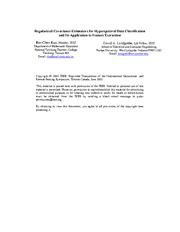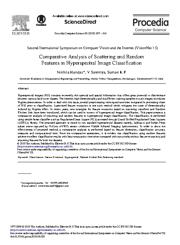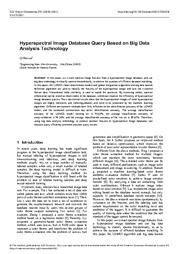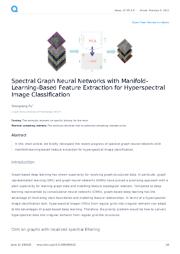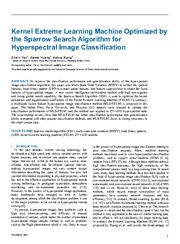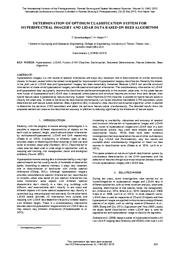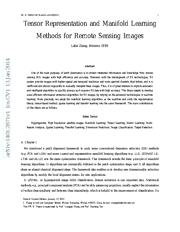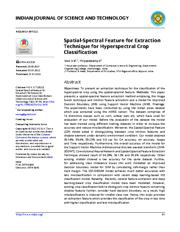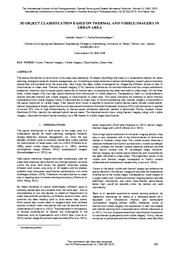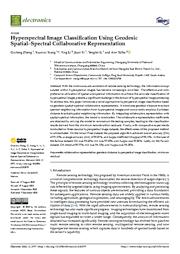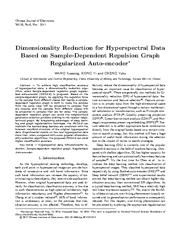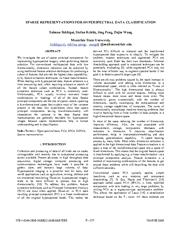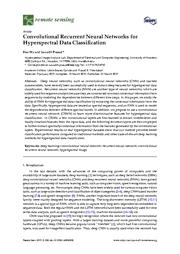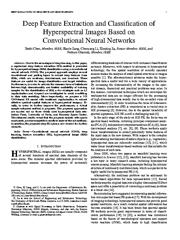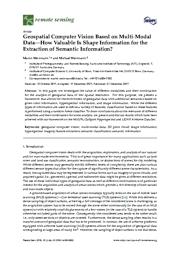A copy of this work was available on the public web and has been preserved in the Wayback Machine. The capture dates from 2017; you can also visit the original URL.
The file type is application/pdf.
Filters
Regularized covariance estimators for hyperspectral data classification and its application to feature extraction
IEEE International Geoscience and Remote Sensing Symposium
Using the proposed covariance estimator to improve the linear feature extraction methods when the multivariate data is singular or nearly so is demonstrated. ...
The main purpose of this work is to find an improved regularized covariance estimator of each class with the advantages of LOOC, and BLOOC, which are useful for high dimensional pattern recognition problems ...
The number of features extracted from the original space is set to L-1. The results of those experiments are shown in Fig. 1. ...
doi:10.1109/igarss.2002.1027232
dblp:conf/igarss/KuoL02a
fatcat:fsgnni5rwnemhn2ulbllxqpgka
Comparative Analysis of Scattering and Random Features in Hyperspectral Image Classification
2015
Procedia Computer Science
extraction) and scattering features for both the datasets. ...
In recent years, new strategies for feature extraction based on scattering transform and Random Kitchen Sink have been introduced, which can be used in context of hyperspectral image classification. ...
Regularized Least Squares: RLS takes the input hyperspectral data and calculates the weight matrix W required for the classification. ...
doi:10.1016/j.procs.2015.08.025
fatcat:6y6ncudzprdvfnhoerfegp2ziq
Hyperspectral Image Database Query Based on Big Data Analysis Technology
2021
E3S Web of Conferences
extracted feature data. ...
In this paper, we extract spectral image features from a hyperspectral image database, and use big data technology to classify spectra hierarchically, to achieve the purpose of efficient database matching ...
In this paper, the LDMGI algorithm and big data branch definition algorithm are used to classify the features of the hyperspectral image and save the extracted feature data. ...
doi:10.1051/e3sconf/202127503018
fatcat:visz74utsjernecda3ewutqjhq
Spectral Graph Neural Networks with Manifold-Learning-Based Feature Extraction for Hyperspectral Image Classification
2022
Qeios
In this short article, we briefly retrospect the recent progress of spectral graph neural networks with manifold-learning-based feature extraction for hyperspectral image classification. ...
Existing publications suggest that additional data denoising could be helpful for downstream hyperspectral image processing and analysis, but for hyperspectral image augmentation and classification tasks ...
Therefore, the priority problem would be how to convert hyperspectral data into irregular domains from regular grid-like structures. ...
doi:10.32388/b899uz
fatcat:zn3frzoxkbfphlaj6e3noyhmt4
Kernel Extreme Learning Machine Optimized by the Sparrow Search Algorithm for Hyperspectral Image Classification
[article]
2022
arXiv
pre-print
, local binary pattern (LBP) to extract spatial features, and feature superposition to obtain the fused features of hyperspectral images. ...
To improve the classification performance and generalization ability of the hyperspectral image classification algorithm, this paper uses Multi-Scale Total Variation (MSTV) to extract the spectral features ...
by noise reduction. (9)
Step2: Extraction of spatial features The spatial features of hyperspectral data are extracted by LBP, an efficient operator for describing texture features, which is defined ...
arXiv:2204.00973v1
fatcat:aapa4zzz4ned3ktb5ro6tb5yae
DETERMINATION OF OPTIMUM CLASSIFICATION SYSTEM FOR HYPERSPECTRAL IMAGERY AND LIDAR DATA BASED ON BEES ALGORITHM
2015
The International Archives of the Photogrammetry, Remote Sensing and Spatial Information Sciences
In this paper feature level fusion of hyperspectral and LiDAR data is proposed where spectral and structural features are extract from both dataset, then hybrid feature space is generated by feature stacking ...
In the past, several efforts have been investigated for improvement of hyperspectral imagery classification. ...
ACKNOWLEDGEMENTS The authors would like to thank the Hyperspectral Image Analysis group and the NSF Funded Center for Airborne Laser 0.34 ...
doi:10.5194/isprsarchives-xl-1-w5-651-2015
fatcat:xdly2zgh25ef7ewf5utvso7zve
Tensor Representation and Manifold Learning Methods for Remote Sensing Images
[article]
2014
arXiv
pre-print
This thesis targets to develop some efficient information extraction algorithms for RS images, by relying on the advanced technologies in machine learning. ...
Thus, it is of great interests to explore automatic and intelligent algorithms to quickly process such massive RS data with high accuracy. ...
Encouraging experimental results on two available hyperspectral data sets indicate that our proposed algorithm outperforms many existing feature extract methods for HSI classification [1] . 2) LDLE: In ...
arXiv:1401.2871v1
fatcat:7riwgc3pc5hcpm3iczsy2tsali
Spatial-Spectral Feature for Extraction Technique for Hyperspectral Crop Classification
2022
Indian Journal of Science and Technology
technique for the classification of the
Spatial-Spectral Feature for
Extraction Technique for hyperspectral crop using the spatial-spectral feature. ...
The Laplacian discriminant examination of hyperspectral image (11) , introduced joint
feature extraction and feature selection strategies for hyperspectral image classification. ...
doi:10.17485/ijst/v15i2.1810
fatcat:v47kupj4mjcezht4ezaj53ziee
3D OBJECT CLASSIFICATION BASED ON THERMAL AND VISIBLE IMAGERY IN URBAN AREA
2015
The International Archives of the Photogrammetry, Remote Sensing and Spatial Information Sciences
Data fusion has been widely investigated for integrating different source of data in classification of urban area. ...
is applied to extract PCs. ...
The proposed pipeline of multi-sensor data classification procedure composed of four steps: data registration, feature extraction, dimension reduction and classification. ...
doi:10.5194/isprsarchives-xl-1-w5-287-2015
fatcat:mecdvat3dbf6zosx6jrp55nt2i
Hyperspectral Image Classification Using Geodesic Spatial–Spectral Collaborative Representation
2023
Electronics
It introduces geodesic distance to extract spectral neighboring information from hyperspectral images and concurrently employs Euclidean distance to extract spatial neighboring information. ...
The effective and comprehensive utilization of spatial and spectral information to achieve the accurate classification of hyperspectral images presents a significant challenge in the domain of hyperspectral ...
Consequently, deep features of hyperspectral data are effectively extracted. ...
doi:10.3390/electronics12183777
fatcat:wn2csavfyne2fdoyzb7com7eqa
Dimensionality Reduction for Hyperspectral Data Based on Sample-Dependent Repulsion Graph Regularized Auto-encoder
2017
Chinese journal of electronics
To achieve high classification accuracy of hyperspectral data, a dimensionality reduction algorithm called Sample-dependent repulsion graph regularized auto-encoder (SRGAE) is proposed. ...
By integrating advantages of deep learning and graph regularization technique, the SRGAE can maintain the learned deep features are consistent with the inherent manifold structure of the original hyperspectral ...
There are generally two methods for Dimensionality reduction (DR) of hyperspectral data: feature extraction and feature selection [4] . ...
doi:10.1049/cje.2017.07.012
fatcat:3u2b3knkabgqjmeul66rl62g7u
Sparse Representations for Hyperspectral Data Classification
2008
IGARSS 2008 - 2008 IEEE International Geoscience and Remote Sensing Symposium
Sparse data representations are generally desirable for hyperspectral images because sparse representations help in human understanding and in classification. ...
We investigate the use of sparse principal components for representing hyperspectral imagery when performing feature selection. ...
Figure 2 : 2 Magnitude of Principal Components used for classification on Hyperspectral data
Figure 3 : 3 Magnitude of Principal Components used for classification on Sonar data II -579
Figure 4 :Figure ...
doi:10.1109/igarss.2008.4779058
dblp:conf/igarss/SiddiquiRPW08
fatcat:zz5do6ynj5bbxnjgfixwqdmx4q
Convolutional Recurrent Neural Networks forHyperspectral Data Classification
2017
Remote Sensing
One-dimensional CNNs were used to extract spectral features for hyperspectral data in [29] . Two-dimensional CNNs had been employed to extract features for hyperspectral data in [30, 31] . ...
Deep neural networks, such as convolutional neural networks (CNN) and stacked autoencoders, have recently been successfully used to extract deep features for hyperspectral data classification. ...
RNN to get the proposed method CRNN for hyperspectral data classification. ...
doi:10.3390/rs9030298
fatcat:kujvwchhiravbjuz7dxui4wa4i
Deep Feature Extraction and Classification of Hyperspectral Images Based on Convolutional Neural Networks
2016
IEEE Transactions on Geoscience and Remote Sensing
Due to the advantages of deep learning, in this paper, a regularized deep feature extraction (FE) method is presented for hyperspectral image (HSI) classification using a convolutional neural network ( ...
Index Terms-Convolutional neural network (CNN), deep learning, feature extraction (FE), hyperspectral image (HSI) classification. ...
Through 3-D convolution, CNN can extract the spatial and spectral information of hyperspectral data simultaneously. The learned features are useful for the further image classification step.
B. ...
doi:10.1109/tgrs.2016.2584107
fatcat:23lh5g76brgplaobyw6ijgjtdm
Geospatial Computer Vision Based on Multi-Modal Data—How Valuable Is Shape Information for the Extraction of Semantic Information?
2017
Remote Sensing
Hyperspectral and LiDAR Airborne Data Set. ...
While the different types of information are used to define a variety of features, classification based on these features is performed using a random forest classifier. ...
Based on the segments, features are extracted and then used as input for classification. ...
doi:10.3390/rs10010002
fatcat:emr6lym54zemdn5gpkwea5n4qm
« Previous
Showing results 1 — 15 out of 6,779 results

